Utilizing Remote Sensing and Satellite-Based Bouguer Gravity data to Predict Potential Sites of Hydrothermal Minerals and Gold Deposits in Central Saudi Arabia
Abstract
1. Introduction
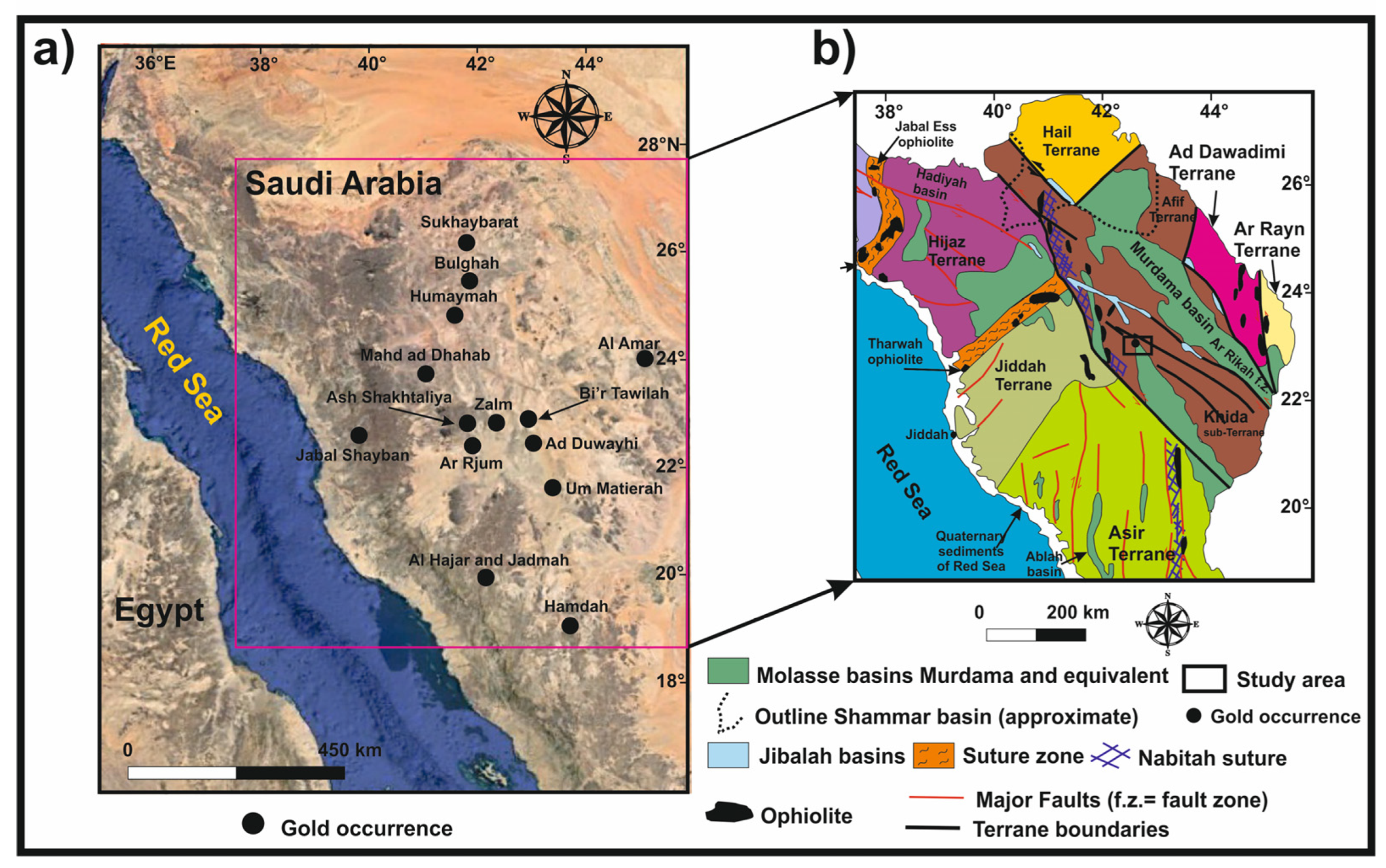
2. Geological Outlines
2.1. Geological Setting
2.2. Gold Mineralization and Structure Setting
3. Materials and Methods
3.1. Remote Sensing Data
3.1.1. Band Ratios (BRs)
3.1.2. Crosta Analysis
3.1.3. Digital Elevation Model (DEM) of SRTM
Fill Sink
Shaded Relief
Lineament Extraction
3.2. Satellite-Based Bouguer Gravity Anomaly
Edge Detection Operators
- Previous Edge Detection Methods
- Recent Edge Detection Methods
4. Results and Discussion
4.1. Remote Sensing (RS) Data
4.1.1. Landsat 8 OLI Data
4.1.2. STRM DEM Data
4.2. Satellite-Based Bouguer Gravity (SBG) Data
4.3. Integration of RS and SBG Results
5. Conclusions
Supplementary Materials
Author Contributions
Funding
Data Availability Statement
Acknowledgments
Conflicts of Interest
References
- Darwish, M.A.; Butt, N.A. Mineral resource potential and its development in Saudi Arabia. Eng. Sci. 1996, 8, 107–120. [Google Scholar] [CrossRef]
- Ministry of Planning KSA. Fourth Development Plan (1985–1990); Ministry of Planning KSA: Riyadh, Saudi Arabia, 1985; pp. 167–184.
- Eldosouky, A.M.; El-Qassas, R.A.Y.; Pham, L.T.; Abdelrahman, K.; Alhumimidi, M.S.; El Bahrawy, A.; Mickus, K.; Sehsah, H. Mapping Main Structures and Related Mineralization of the Arabian Shield (Saudi Arabia) Using Sharp Edge Detector of Transformed Gravity Data. Minerals 2022, 12, 71. [Google Scholar] [CrossRef]
- Harbi, H.A.; Eldougdoug, A.A.; Al Jahdali, N.S. Evolution of the Arabian shield and associated mineralization. In Proceedings of the 9th Arab Conference of Mineral Resources, Jeddah, Saudi Arabia, 30 October–1 November 2006; pp. 1–11. [Google Scholar]
- Al-Shanti, A.M.S. Geology of the Arabian Shield; Center for Scientific Publishing, King Abdlaziz University: Jeddah, Saudi Arabia, 1993. [Google Scholar]
- Collenette, P.; Grainger, D.J. Mineral Resources of Saudi Arabia, not Including Oil, Natural Gas, and Sulfur. In Ministry of Petroleum and Mineral Resources, Directorate General of Mineral Resources; Ministry of Petroleum Saudi: Jeddah, Saudi Arabia, 1994. [Google Scholar]
- Nehlig, P.; Salpeteur, I.; Asfirane, F.; Bouchot, V.; Eberlé, J.M.; Genna, A. The mineral potential of the Arabian shield: A reassessment. In Proceedings of the IUGS/UNESCO Meeting on the “Base and Precious Metal Deposits in the Arabian Shield”, Jeddah, Saudi Arabia, 12–19 November 1999; pp. 12–19. [Google Scholar]
- Leistel, J.M.; Al Jahdali, N.; Khalil, I.; Kattu, G.; Eberle, J.M.; Lambert, A.; Siddiqui, A.; Saleh, Y. Results of Precious Metal Exploration in the Zalim Prospect, Kingdom of Saudi Arabia; Ministry of Petroleum and Mineral Resources, Deputy Ministry for Mineral Resources: Jeddah, Saudi Arabia, 1999; Technical Report; BRGM-TR-99-14; 108p.
- Al Jahdli, N.S. Geology of Jabal Ghadarah Area, Bi’r Tawilah District with Special Emphasis on Listvinite as a Potential Source for Gold in the Kingdom of Saudi Arabia’, M.Sc.; King Abdulaziz University: Jeddah, Saudi Arabia, 2004. [Google Scholar]
- Doebrich, J.L.; Zahony, S.G.; Leavitt, J.D.; Portacio, J.S., Jr.; Siddiqui, A.A.; Wooden, J.L.; Fleck, R.J.; Stein, H.J. Ad Duwayhi, Saudi Arabia: Geology and geochronology of a Neoproterozoic intrusion-related gold system in the Arabian Shield. Econ. Geol. 2004, 99, 713–741. [Google Scholar] [CrossRef]
- Agar, R.A.; Stacey, J.S.; Whitehouse, M.J. Evolution of Southern Afif Terrane: A Geochronologic Study; Ministry of Petroleum and Mineral Resources, Deputy Ministry for Mineral Resources: Jeddah, Saudi Arabia, 1992; Open-File-Report; DGMR-OF-10-15; 46p.
- Abdelkareem, M.; El-Baz, F. Characterizing hydrothermal alteration zones in Hamama area in the central Eastern Desert of Egypt by remotely sensed data. Geocarto Int. 2017, 33, 1307–1325. [Google Scholar] [CrossRef]
- Ahmed, A.A.; Abdelkareem, M.; Asran, A.M.; Mahran, T.M. Geomorphic and lithologic characteristics of Wadi Feiran basin, Southern Sinai, Egypt, using remote sensing and field investigations. J. Earth Syst. Sci. 2017, 126, 85. [Google Scholar] [CrossRef]
- Abdelkareem, M.; El-Din, G.M.K.; Osman, I. An integrated approach for mapping mineral resources in the Eastern Desert of Egypt. Int. J. Appl. Earth Obs. Geoinf. 2018, 73, 682–696. [Google Scholar] [CrossRef]
- Sultan, M.; Arvidson, R.E.; Sturchio, N.C. Mapping of serpentinites in the Eastern Desert of Egypt by using Landsat thematic mapper data. Geology 1986, 14, 995–999. [Google Scholar] [CrossRef]
- Abdelsalam, M.G.; Stern, R.J.; Berhane, W.G. Mapping gossans in arid regions with Landsat TM and SIR-C images: The Beddaho Alteration Zone in northern Eritrea. J. Afr. Earth Sci. 2000, 30, 903–916. [Google Scholar] [CrossRef]
- Madani, A.A.; Rahman, E.M.A.; WZY, K.M.F.A.; Emam, A. Mapping of the hydrothermal alteration zones at Haimur gold mine area, South Eastern Desert, Egypt, using remote sensing techniques. Egypt. J. Remote Sens. Space Sci. 2003, 6, 47–60. [Google Scholar]
- Ramadan, T.M.; Kontny, A. Mineralogical and structural characterization of alteration zones detected by orbital remote sensing at Shalatein District, SE Desert, Egypt. J. Afr. Earth Sci. 2004, 40, 89–99. [Google Scholar] [CrossRef]
- Abdelkareem, M.; El-Baz, F. Mode of formation of the Nile Gorge in northern Egypt: A study by DEM-SRTM data and GIS analysis. Geol. J. 2015, 51, 760–778. [Google Scholar] [CrossRef]
- El Khidir, S.O.; Babikir, I.A. Digital image processing and geospatial analysis of landsat 7 ETM+ for mineral exploration, Abidiya area, North Sudan. Int. J. Geomat. Geosci. 2013, 3, 645–658. [Google Scholar]
- Amuda, O.S.; Adebisi, S.A.; Jimoda, L.A.; Alade, A.O. Challenges and possible panacea to the municipal solid wastes management in Nigeria. J. Sustain. Dev. Stud 2014, 6, 64–70. [Google Scholar]
- Poormirzaee, R.; Oskouei, M.M. Use of spectral analysis for detection of alterations in ETM data, Yazd, Iran. Appl. Geomat. 2010, 2, 147–154. [Google Scholar] [CrossRef][Green Version]
- El-Din, G.K.; Abdelkareem, M. Integration of remote sensing, geochemical and field data in the Qena-Safaga shear zone: Implications for structural evolution of the Eastern Desert, Egypt. J. Afr. Earth Sci. 2018, 141, 179–193. [Google Scholar] [CrossRef]
- Goetz, A.F.H.; Rock, B.N.; Rowan, L.C. Remote sensing for exploration; an overview. Econ. Geol. 1983, 78, 573–590. [Google Scholar] [CrossRef]
- Kafadar, O. CURVGRAV-GUI: A graphical user interface to interpret gravity data using curvature technique. Earth Sci. Inform. 2017, 10, 525–537. [Google Scholar] [CrossRef]
- Eldosouky, A.M.; Saada, S.A. Source edge detection (SED) of aeromagnetic data: Synthetic examples and a case study from Haimur area, south Eastern Desert, Egypt. Arab. J. Geosci. 2020, 13, 1–12. [Google Scholar] [CrossRef]
- Pham, L.T.; Oksum, E.; Vu, M.D.; Vo, Q.T.; Du Le-Viet, K.; Eldosouky, A.M. An improved approach for detecting ridge locations to interpret the potential field data for more accurate structural mapping: A case study from Vredefort dome area (South Africa). J. Afr. Earth Sci. 2020, 175, 104099. [Google Scholar] [CrossRef]
- Eldosouky, A.M.; Mohamed, H. Edge detection of aeromagnetic data as effective tools for structural imaging at Shilman area, South Eastern Desert, Egypt. Arab. J. Geosci. 2021, 14, 1–10. [Google Scholar] [CrossRef]
- El-Raouf, A.A.; Doğru, F.; Abdelrahman, K.; Fnais, M.S.; El Manharawy, A.; Amer, O. Using Airborne Geophysical and Geochemical Methods to Map Structures and Their Related Gold Mineralization. Minerals 2023, 13, 237. [Google Scholar] [CrossRef]
- Eldosouky, A.M.; Sehsah, H.; Elkhateeb, S.O.; Pour, A.B. Integrating aeromagnetic data and Landsat-8 imagery for detection of post-accretionary shear zones controlling hydrothermal alterations: The Allaqi-Heiani Suture zone, South Eastern Desert, Egypt. Adv. Space Res. 2019, 65, 1008–1024. [Google Scholar] [CrossRef]
- Oksum, E.; Le, D.V.; Vu, M.D.; Nguyen, T.H.T.; Pham, L.T. A novel approach based on the fast sigmoid function for interpretation of potential field data. Bull. Geophys. Ocean. 2021, 62, 543–556. [Google Scholar]
- Kharbish, S.; Eldosouky, A.M.; Amer, O. Integrating mineralogy, geochemistry and aeromagnetic data for detecting Fe–Ti ore deposits bearing layered mafic intrusion, Akab El-Negum, Eastern Desert, Egypt. Sci. Rep. 2022, 12, 15474. [Google Scholar] [CrossRef]
- Pham, L.T. A comparative study on different filters for enhancing potential field source boundaries: Synthetic examples and a case study from the Song Hong Trough (Vietnam). Arab. J. Geosci. 2020, 13, 723. [Google Scholar] [CrossRef]
- Pham, L.T. A high resolution edge detector for interpreting potential field data: A case study from the Witwatersrand basin, South Africa. J. Afr. Earth Sci. 2021, 178, 104190. [Google Scholar] [CrossRef]
- Hang, N.T.T.; Thanh, D.D.; Minh, L.H. Application of directional derivative method to determine boundary of magnetic sources by total magnetic anomalies. J. Sci. Earth 2017, 39, 362–375. [Google Scholar] [CrossRef]
- Pham, L.T.; Oksum, E.; Kafadar, O.; Trinh, P.T.; Nguyen, D.V.; Vo, Q.T.; Le, S.T.; Do, T.D. Determination of subsurface lineaments in the Hoang Sa islands using enhanced methods of gravity total horizontal gradient. Vietnam J. Earth Sci. 2022, 43, 395–409. [Google Scholar]
- Eldosouky, A.M.; Pham, L.T.; Abdelrahman, K.; Fnais, M.S.; Gomez-Ortiz, D. Mapping structural features of the Wadi Umm Dulfah area using aeromagnetic data. J. King Saud Univ.-Sci. 2021, 34, 101803. [Google Scholar] [CrossRef]
- Eldosouky, A.M.; Pham, L.T.; Mohmed, H.; Pradhan, B. A comparative study of THG, AS, TA, Theta, TDX and LTHG techniques for improving source boundaries detection of magnetic data using synthetic models: A case study from G. Um Monqul, North Eastern Desert, Egypt. J. Afr. Earth Sci. 2020, 170, 103940. [Google Scholar] [CrossRef]
- Miller, H.G.; Singh, V. Potential field tilt—A new concept for location of potential field sources. J. Appl. Geophys. 1994, 32, 213–217. [Google Scholar] [CrossRef]
- Wijns, C.; Perez, C.; Kowalczyk, P. Theta map: Edge detection in magnetic data. Geophysics 2005, 70, L39–L43. [Google Scholar] [CrossRef]
- Nehlig, P.; Genna, A.; Asfirane, F.; Guerrot, C.; Eberlé, J.; Kluyver, H.; Lasserre, J.; Le Goff, E.; Nicol, N.; Salpeteur, N.; et al. A review of the Pan-African evolution of the Arabian Shield. Geoarabia 2002, 7, 103–124. [Google Scholar] [CrossRef]
- Johnson, P.R.; Woldehaimanot, B. Development of the Arabian-Nubian Shield: Perspectives on accretion and deformation in the northern East African Orogen and the assembly of Gondwana. Geol. Soc. Lond. Spéc. Publ. 2003, 206, 289–325. [Google Scholar] [CrossRef]
- Stern, R.J.; Johnson, P. Continental lithosphere of the Arabian Plate: A geologic, petrologic, and geophysical synthesis. Earth-Sci. Rev. 2010, 101, 29–67. [Google Scholar] [CrossRef]
- Johnson, P.R. Tectonic development of the Arabian Shield: An overview. In US Geological Survey Saudi Arabia Mission, IUGS/UNESCO Deposit Modelling Workshop; Ministry of Petroleum and Mineral Resources, Deputy Ministry for Mineral Resources: Jeddah, Saudi Arabia, 1999. [Google Scholar]
- Johnson, P.R. Post-amalgamation basins of the NE Arabian shield and implications for Neoproterozoic III tectonism in the northern East African orogen. Precambrian Res. 2003, 123, 321–337. [Google Scholar] [CrossRef]
- Stacey, J.S.; Agar, R.A. U-Pb isotopic evidence for the accretion of a continental microplate in the Zalm region of the Saudi Arabian Shield. J. Geol. Soc. 1985, 142, 1189–1203. [Google Scholar] [CrossRef]
- Agar, R.A. Geologic map of the Zalm quadrangle, sheet 22F, Kingdom of Saudi Arabia. Saudi Arab. Deputy Minist. Miner. Resour. Geol. Map GM 1989, 89, 41. [Google Scholar]
- Sabir, H.; Labbé, J.F. Bi’r Tawilah tungsten prospect, Najd region, Kingdom of Saudi Arabia. J. Afr. Earth Sci. (1983) 1986, 4, 249–255. [Google Scholar] [CrossRef]
- Surour, A.A.; Harbi, H.M.; Ahmed, A.H. The Bi’r Tawilah deposit, central western Saudi Arabia: Supergene enrichment of a Pan-African epithermal gold mineralization. J. Afr. Earth Sci. 2014, 89, 149–163. [Google Scholar] [CrossRef]
- Zeinelabdein, K.A.E.; Elemam, M.S.; Ali, H.A.; Alhassan, O.M. An integrated analysis of Landsat OLI image and satellite gravity data for geological mapping in North Kordofan State, Sudan. Am. J. Earth Sci. 2014, 1, 25–32. [Google Scholar]
- Javhar, A.; Chen, X.; Jovid, A.; Yunus, M.; Jamshed, A.; Eldiiar, D.; Zulfiyor, B. Evaluation of remote sensing techniques for lithological mapping in the southeastern Pamir using Landsat 8 OLI data. Int. J. Geoinformatics 2018, 14, 1–10. [Google Scholar]
- Green, A.; Berman, M.; Switzer, P. Craig A transformation for ordering multispectral data in terms of image quality with implications for noise removal. IEEE Trans. Geosci. Remote. Sens. 1988, 26, 65–74. [Google Scholar] [CrossRef]
- Vermillion, S.C.; Sader, S.A. Use of the minimum noise fraction (MNF) transform to analyze airborne visible/infrared imaging spectrometer (AVIRIS) data of northern forest types. AVIRIS Workshop 1999, 7. [Google Scholar]
- Boardman, J.W.; Kruse, F.A. Automated spectral analysis: A geologic example using AVIRIS data, north Grapevine Mountais. San Antonio. In Proceedings of the Tenth Thematic Conference, Geologic Remote Sensing, San Antonio, TX, USA, 9–12 May 1994; pp. I-407–I-418. [Google Scholar]
- Amer, R.; Kusky, T.; Ghulam, A. Lithological mapping in the Central Eastern Desert of Egypt using ASTER data. J. Afr. Earth Sci. 2010, 56, 75–82. [Google Scholar] [CrossRef]
- Ali, A.S.; Pour, A.B. Lithological mapping and hydrothermal alteration using Landsat 8 data: A case study in ariab mining district, red sea hills, Sudan. Int. J. Basic Appl. Sci. 2014, 3, 199. [Google Scholar] [CrossRef]
- Mhamdi, H.S.; Raji, M.; Maimouni, S.; Oukassou, M. Fractures network mapping using remote sensing in the Paleozoic massif of Tichka (Western High Atlas, Morocco). Arab. J. Geosci. 2017, 10, 125. [Google Scholar] [CrossRef]
- Goetz, A.F.H.; Rowan, L.C.; Kingston, M.J. Mineral Identification from Orbit: Initial Results from the Shuttle Multispectral Infrared Radiometer. Science 1982, 218, 1020–1024. [Google Scholar] [CrossRef]
- Mars, J.C.; Rowan, L.C. Regional mapping of phyllic-and argillic-altered rocks in the Zagros magmatic arc, Iran, using Advanced Spaceborne Thermal Emission and Reflection Radiometer (ASTER) data and logical operator algorithms. Geosphere 2006, 2, 161–186. [Google Scholar] [CrossRef]
- Pour, A.B.; Hashim, M. Hydrothermal alteration mapping from Landsat-8 data, Sar Cheshmeh copper mining district, south-eastern Islamic Republic of Iran. J. Taibah Univ. Sci. 2015, 9, 155–166. [Google Scholar] [CrossRef]
- Loughlin, W.P. Principal component analysis for alteration mapping. Photogramm. Eng. Remote Sens. 1991, 57, 1163–1169. [Google Scholar]
- Kokaly, R.F.; Clark, R.N.; Swayze Gregg, A.; Livo KEric Hoefen Todd, M.; Pearson Neil, C.; Wise Richard, A.; Benzel William Lowers Heather, A.; Driscoll Rhonda, L.; Klein Anna, J. USGS Digital Spectral Library; US Geological Survey: Reston, VA, USA, 2017. [CrossRef]
- Rabus, B.; Eineder, M.; Roth, A.; Bamler, R. The shuttle radar topography mission—A new class of digital elevation models acquired by spaceborne radar. ISPRS J. Photogramm. Remote. Sens. 2003, 57, 241–262. [Google Scholar] [CrossRef]
- Smith, M.J.; Clark, C.D. Methods for the visualization of digital elevation models for landform mapping. Earth Surf. Process. Landf. 2005, 30, 885–900. [Google Scholar] [CrossRef]
- Ganas, A.; Athanassiou, E. A comparative study on the production of satellite orthoimagery for geological remote sensing. Geocarto International 2000, 15, 53–62. [Google Scholar] [CrossRef]
- Environmental Systems Resource Institute. ArcGIS Desktop Sofware, Release 10; Environmental Systems Resource Institute: Redlands, CA, USA, 2012. [Google Scholar]
- Adiri, Z.; El Harti, A.; Jellouli, A.; Lhissou, R.; Maacha, L.; Azmi, M.; Zouhair, M.; Bachaoui, E.M. Comparison of Landsat-8, ASTER and Sentinel 1 satellite remote sensing data in automatic lineaments extraction: A case study of Sidi Flah-Bouskour inlier, Moroccan Anti Atlas. Adv. Space Res. 2017, 60, 2355–2367. [Google Scholar] [CrossRef]
- Thannoun, R.G. Automatic extraction and geospatial analysis of lineaments and their tectonic significance in some areas of Northern Iraq using remote sensing techniques and GIS. Int. J. Enhanc. Res. Sci. Technol. Eng. Bull. 2013, 2, 1–11. [Google Scholar]
- Liang, W.; Li, J.; Xu, X.; Zhang, S.; Zhao, Y. A high-resolution Earth’s gravity field model SGG-UGM-2 from GOCE, GRACE, satellite altimetry, and EGM2008. Engineering 2020, 6, 860–878. [Google Scholar] [CrossRef]
- Roest, W.R.; Verhoef, J.; Pilkington, M. Magnetic interpretation using the 3-D analytic signal. Geophysics 1992, 57, 116–125. [Google Scholar] [CrossRef]
- Prasad, K.N.D.; Pham, L.T.; Singh, A.P. Structural mapping of potential field sources using BHG filter. Geocarto Int. 2022, 37, 11253–11280. [Google Scholar] [CrossRef]
- Cordell, L. Gravimetric expression of graben faulting in Santa Fe country and the Espanola basin. In Guidebook to Santa Fe Country, 30th Field Conference; New Mexico Geological Survey: Leroy Place Socorro, NM, USA, 1979; pp. 59–64. [Google Scholar]
- Ferreira, J.; de Souza, J.; de Bongiolo, A.; de Castro, L.G. Enhancement of the total horizontal gradient of magnetic anomalies using the tilt angle. Geophysics 2013, 78, J33–J41. [Google Scholar] [CrossRef]
- Ibraheem, I.M.; Haggag, M.; Tezkan, B. Edge Detectors as Structural Imaging Tools Using Aeromagnetic Data: A Case Study of Sohag Area, Egypt. Geosciences 2019, 9, 211. [Google Scholar] [CrossRef]
- Cooper, G.; Cowan, D. Enhancing potential field data using filters based on the local phase. Comput. Geosci. 2006, 32, 1585–1591. [Google Scholar] [CrossRef]
- Al-Badani, M.A.; Al-Wathaf, Y.M. Using the aeromagnetic data for mapping the basement depth and contact locations, at southern part of Tihamah region, western Yemen. Egypt. J. Pet. 2018, 27, 485–495. [Google Scholar] [CrossRef]
- Verduzco, B.; Fairhead, J.D.; Green, C.M.; MacKenzie, C. New insights into magnetic derivatives for structural mapping. Geophysics 2004, 23, 116–119. [Google Scholar] [CrossRef]
- Pham, L.T.; Eldosouky, A.M.; Abdelrahman, K.; Fnais, M.S.; Gomez-Ortiz, D.; Khedr, F. Application of the improved parabola-based method in delineating lineaments of subsurface structures: A case study. J. King Saud Univ.-Sci. 2021, 33, 101585. [Google Scholar] [CrossRef]
- Cooper, G.R. Reducing the dependence of the analytic signal amplitude of aeromagnetic data on the source vector directionSignal amplitude of aeromagnetic data. Geophysics 2014, 79, J55–J60. [Google Scholar] [CrossRef]
- Sabins, F.F. Remote sensing for mineral exploration. Ore Geol. Rev. 1999, 14, 157–183. [Google Scholar] [CrossRef]
- Ramadan, T.M.; Sultan, S.A. Integration of geological, remote sensing and geophysical data for the identification of massive sulphide zones at Wadi Allaqi area, South Eastern Desert, Egypt. In Proceedings of the IGARSS 2003. 2003 IEEE International Geoscience and Remote Sensing Symposium. Proceedings (IEEE Cat. No. 03CH37477), Toulouse, France, 21–25 July 2003; pp. 2589–2592. [Google Scholar]
- Gabr, S.S.; Diab, H.; Fattah, T.A.A.; Sadek, M.F.; Khalil, K.I.; Youssef, M.A. Aeromagnetic and Landsat-8 data interpretation for structural and hydrothermal alteration mapping along the Central and Southern Eastern Desert boundary, Egypt. Egypt. J. Remote Sens. Space Sci. 2021, 25, 11–20. [Google Scholar] [CrossRef]
- Crosta, A.P. Enhancement of Landsat Thematic Mapper imagery for residual soil mapping in SW Minas Gerais State Brazil, a prospecting case history in greenstone belt terrain. In Proceedings of the 7th ERIM Thematic Conference on Remote Sensing for Exploration Geology, Calgary, AL, Canada, 2–6 October 1989. [Google Scholar]
- Osinowo, O.O.; Gomy, A.; Isseini, M. Mapping hydrothermal alteration mineral deposits from Landsat 8 satellite data in Pala, Mayo Kebbi Region, Southwestern Chad. Sci. Afr. 2021, 11, e00687. [Google Scholar] [CrossRef]
- Pour, A.B.; Hashim, M.; Hong, J.K.; Park, Y. Lithological and alteration mineral mapping in poorly exposed lithologies using Landsat-8 and ASTER satellite data: North-eastern Graham Land, Antarctic Peninsula. Ore Geol. Rev. 2019, 108, 112–133. [Google Scholar] [CrossRef]
- Hubbard, B.M.; Thompson, T.J. Lineament Analysis of Mineral Areas of Interest in Afghanistan: Automatically Delineated Lineaments using 30-m TM Imagery; US Geological Survey: Reston, VA, USA, 2012; Open-File Report; 28p.
- Melouah, O.; Eldosouky, A.M.; Ebong, E.D. Crustal architecture, heat transfer modes and geothermal energy potentials of the Algerian Triassic provinces. Geothermics 2021, 96, 102211. [Google Scholar] [CrossRef]
- Pham, L.T.; Oksum, E.; Le, D.V.; Ferreira, F.J.; Le, S.T. Edge detection of potential field sources using the softsign function. Geocarto Int. 2022, 37, 4255–4268. [Google Scholar] [CrossRef]
- Rigol-Sanchez, J.P.; Chica-Olmo, M.; Abarca-Hernandez, F. Artificial neural networks as a tool for mineral potential mapping with GIS. Int. J. Remote Sens. 2003, 24, 1151–1156. [Google Scholar] [CrossRef]
- Woldai, T.; Pistocchi, A.; Master, S. Validation and sensitivity analysis of a mineral potential model using favourability functions. Monash University Epress 2006, 2, 1. [Google Scholar] [CrossRef][Green Version]
- Alexander, I.; Samuel, O.O.; Esther, C.M. Integrating Landsat-ETM and Aeromagnetic data for enhanced structural interpretation over Naragwata area, North-Central Nigeria. Int. J. Sci. Eng. Res. 2015, 6, 2229–5518. [Google Scholar]
- Irons, J.R.; Dwyer, J.L.; Barsi, J.A. The next Landsat satellite: The Landsat data continuity mission. Remote Sens. Environ. 2012, 122, 11–21. [Google Scholar] [CrossRef]
- Roy, D.P.; Wulder, M.A.; Loveland, T.R.; Woodcock, C.E.; Allen, R.G.; Anderson, M.C.; Helder, D.; Irons, J.R.; Johnson, D.M.; Kennedy, R.; et al. Landsat-8: Science and product vision for terrestrial global change research. Remote Sens. Environ. 2014, 145, 154–172. [Google Scholar] [CrossRef]
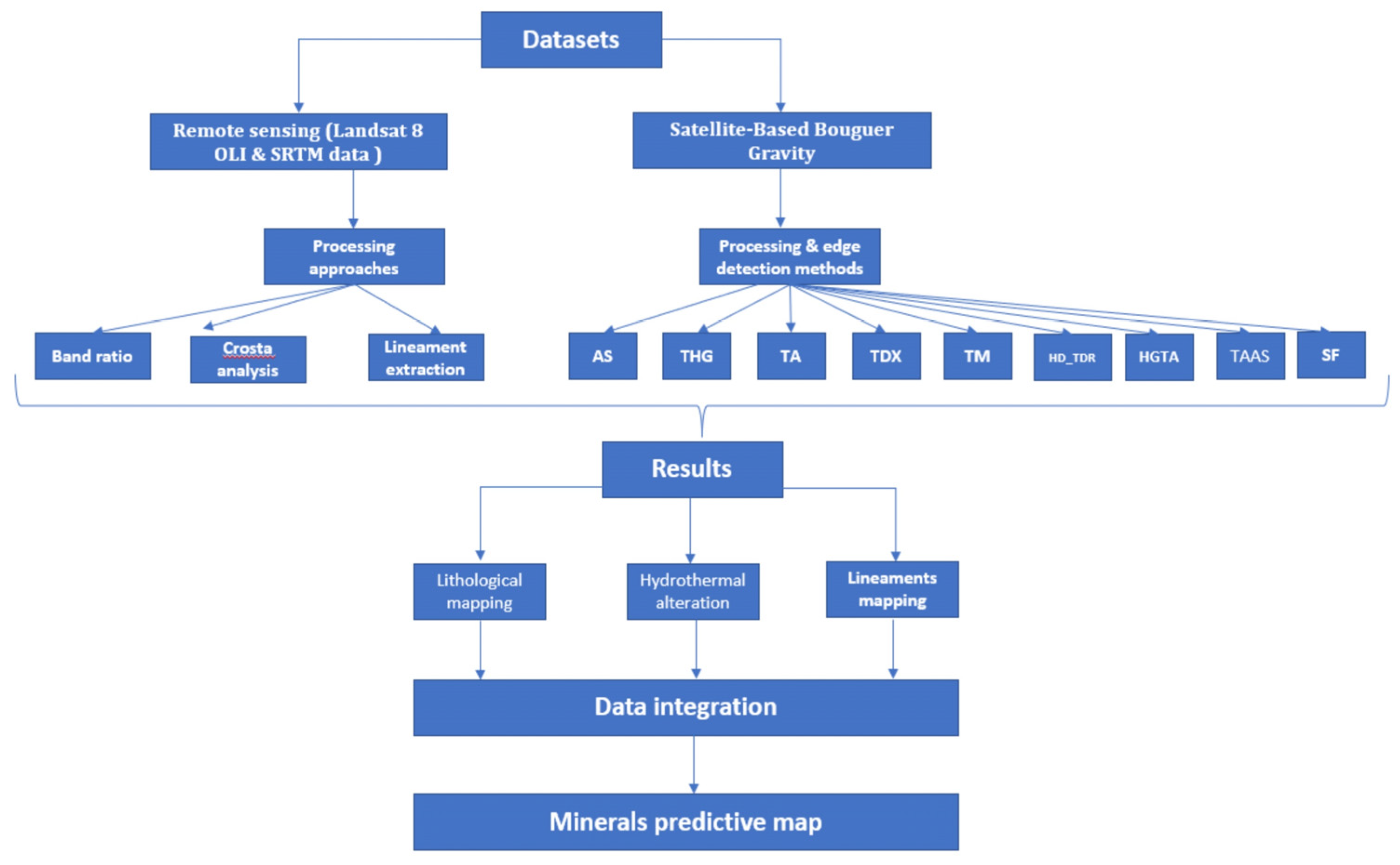

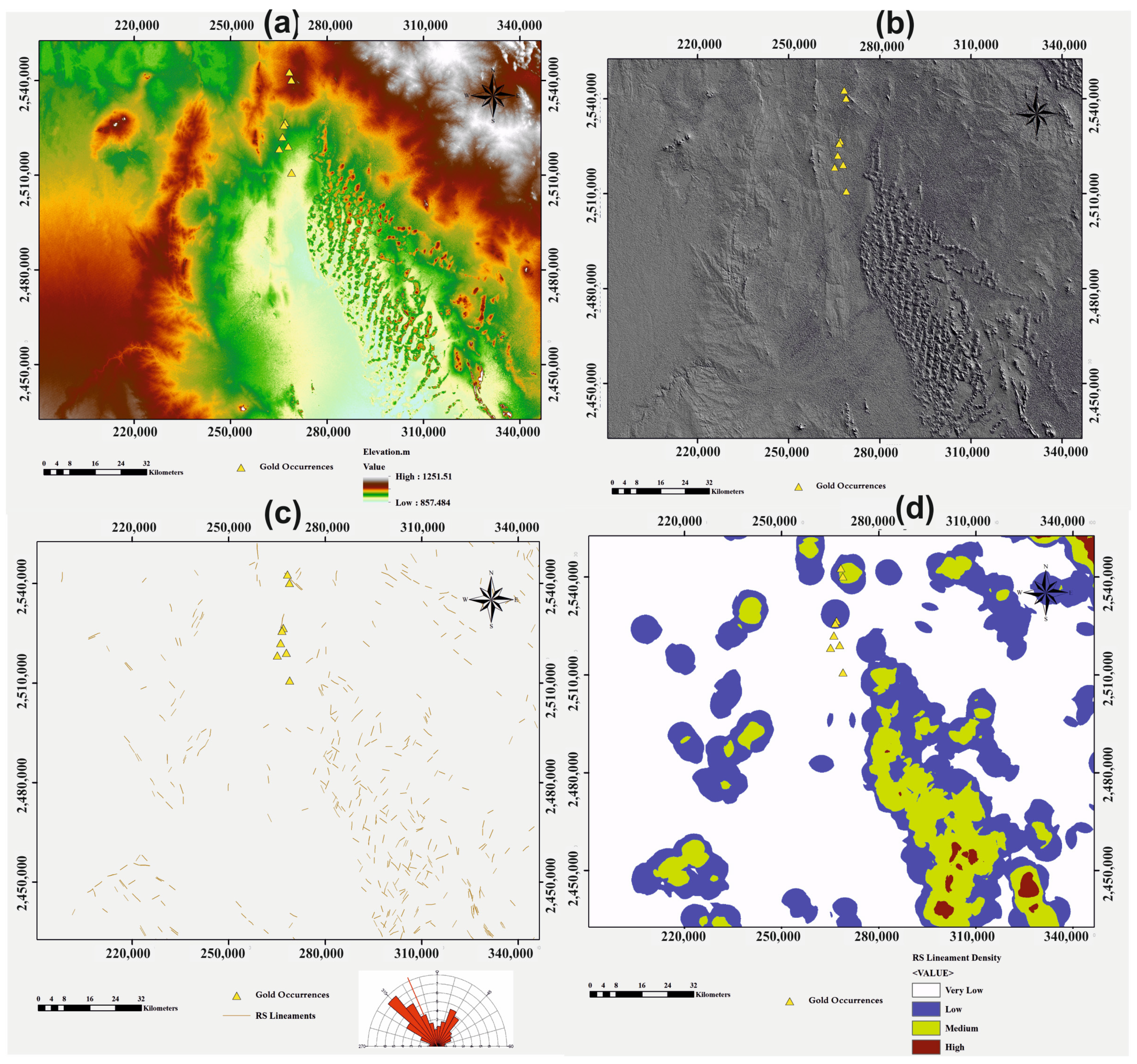
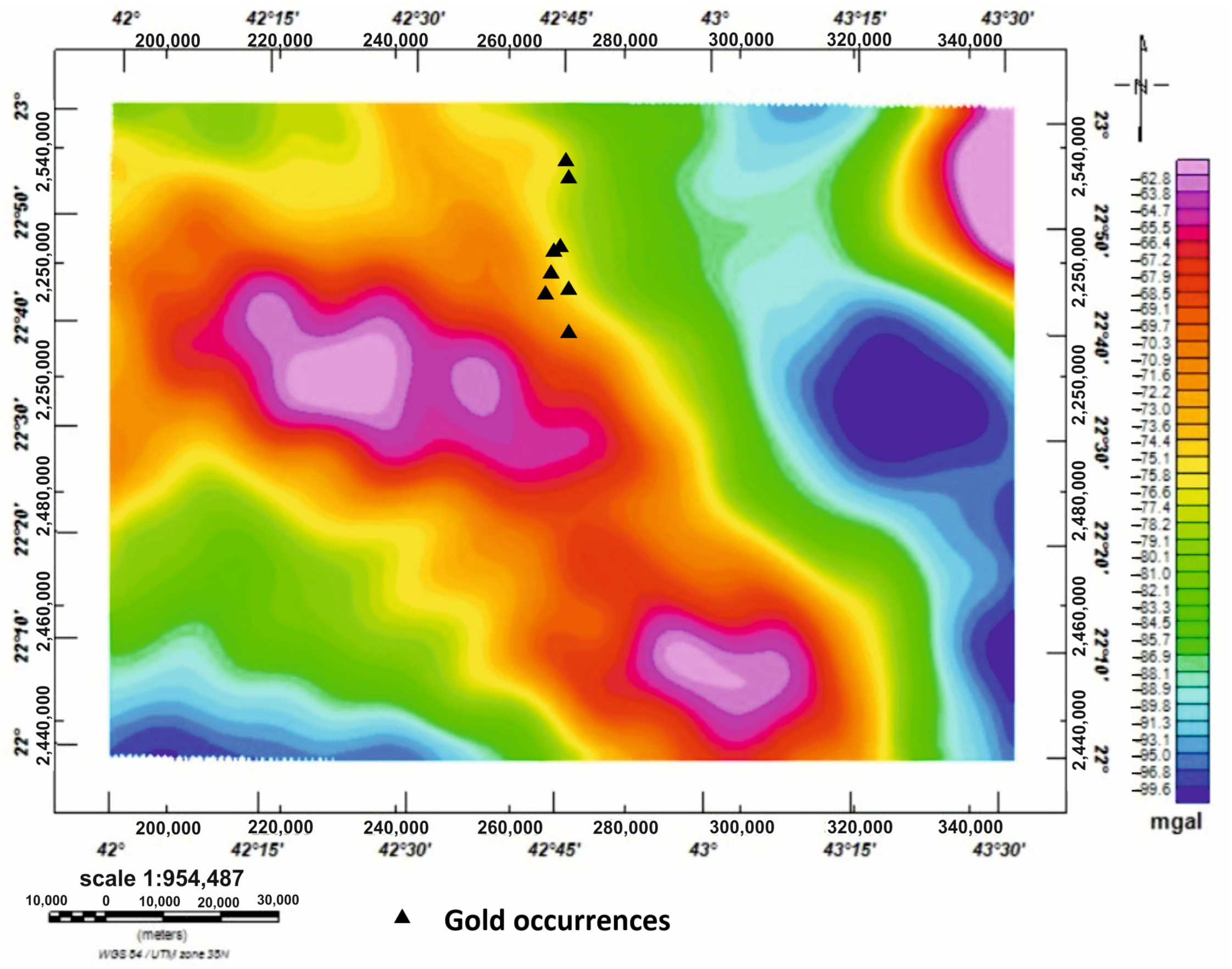
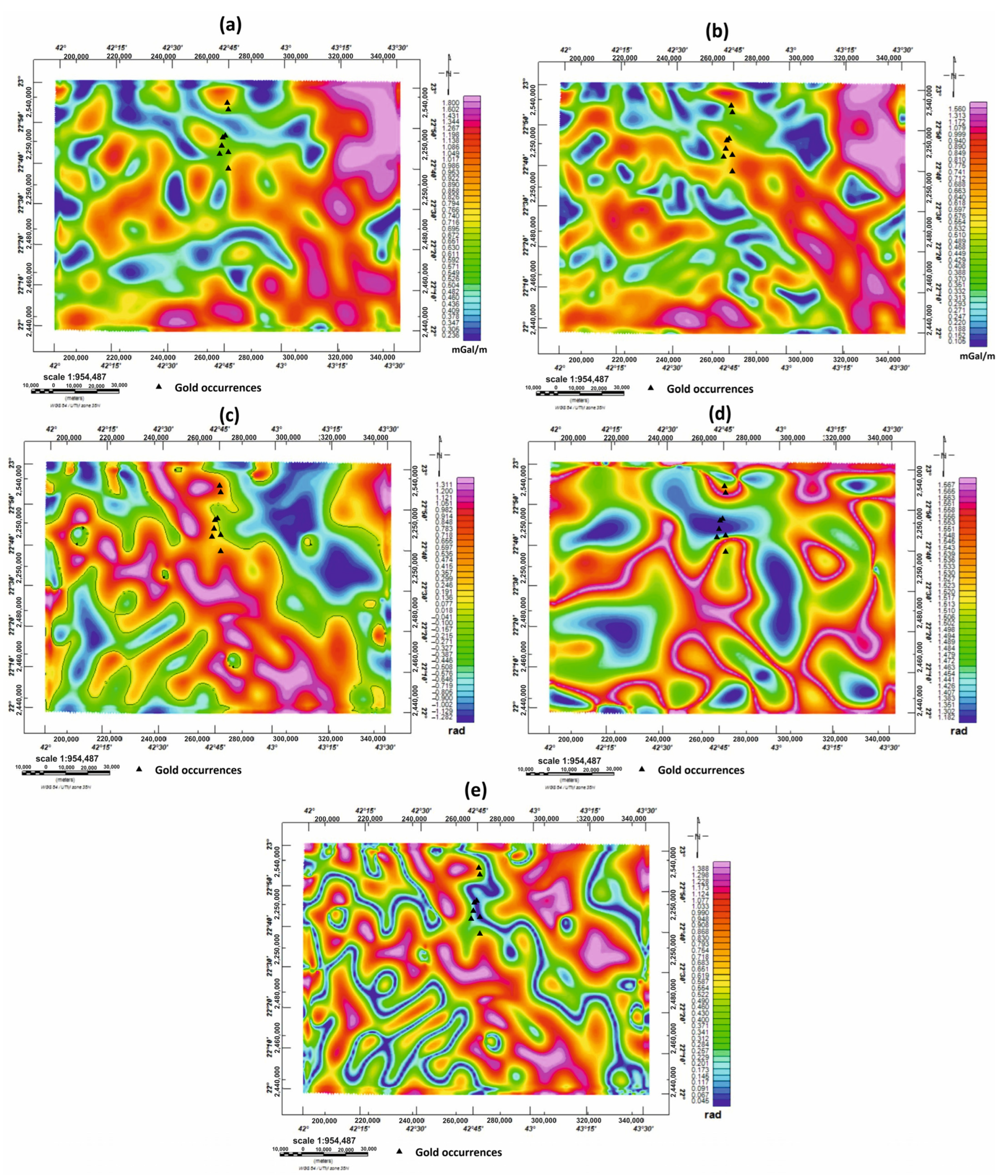
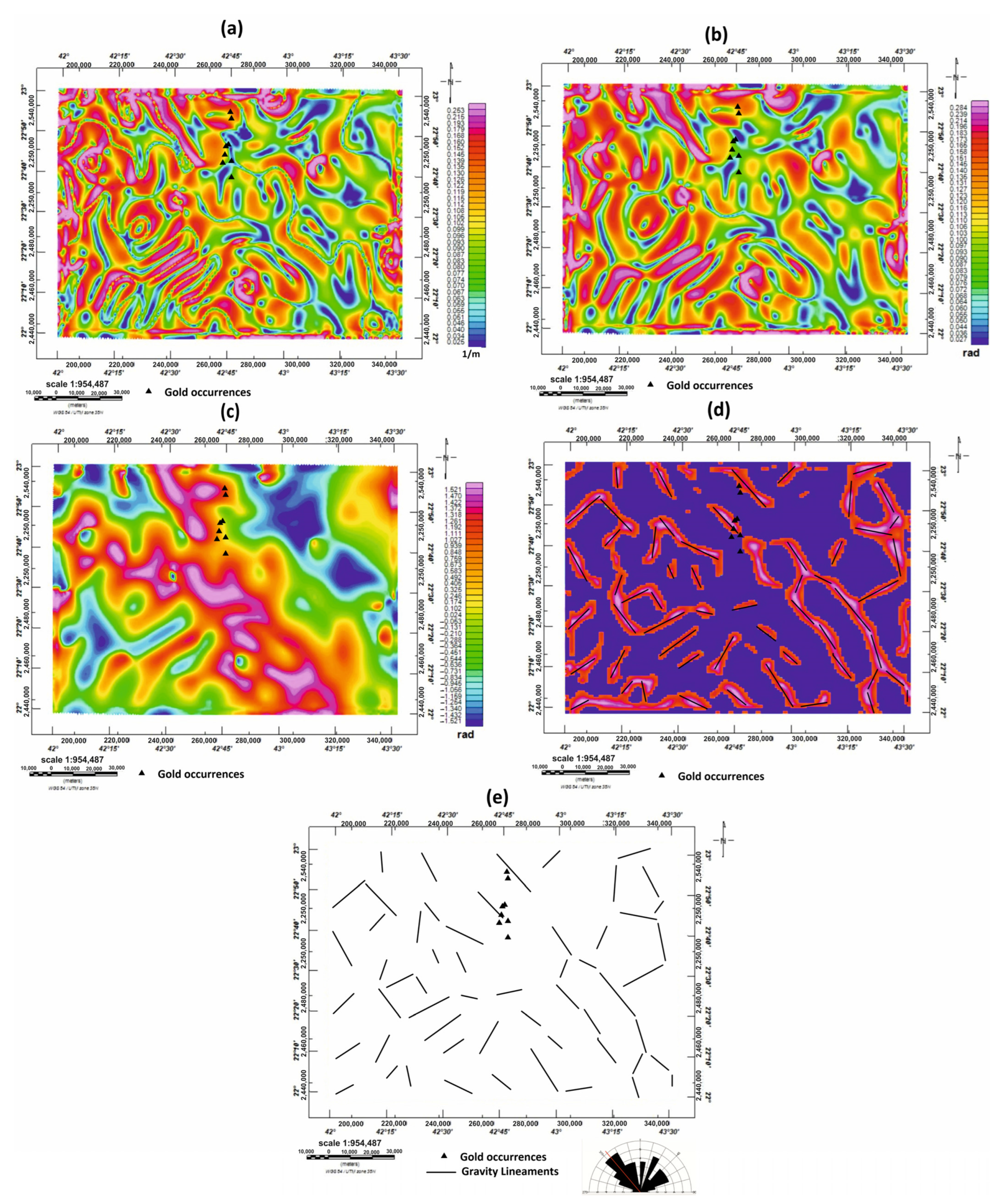
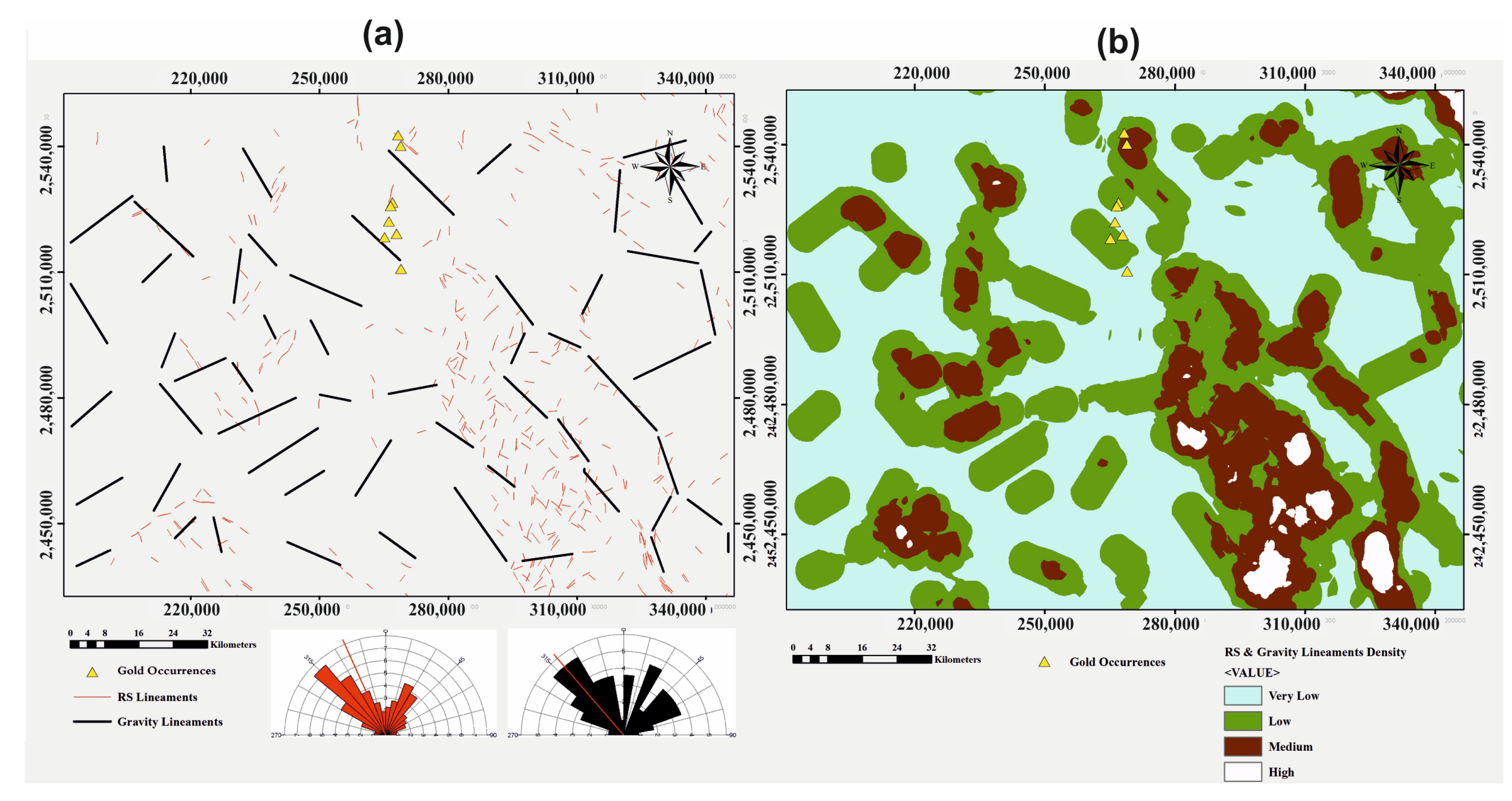
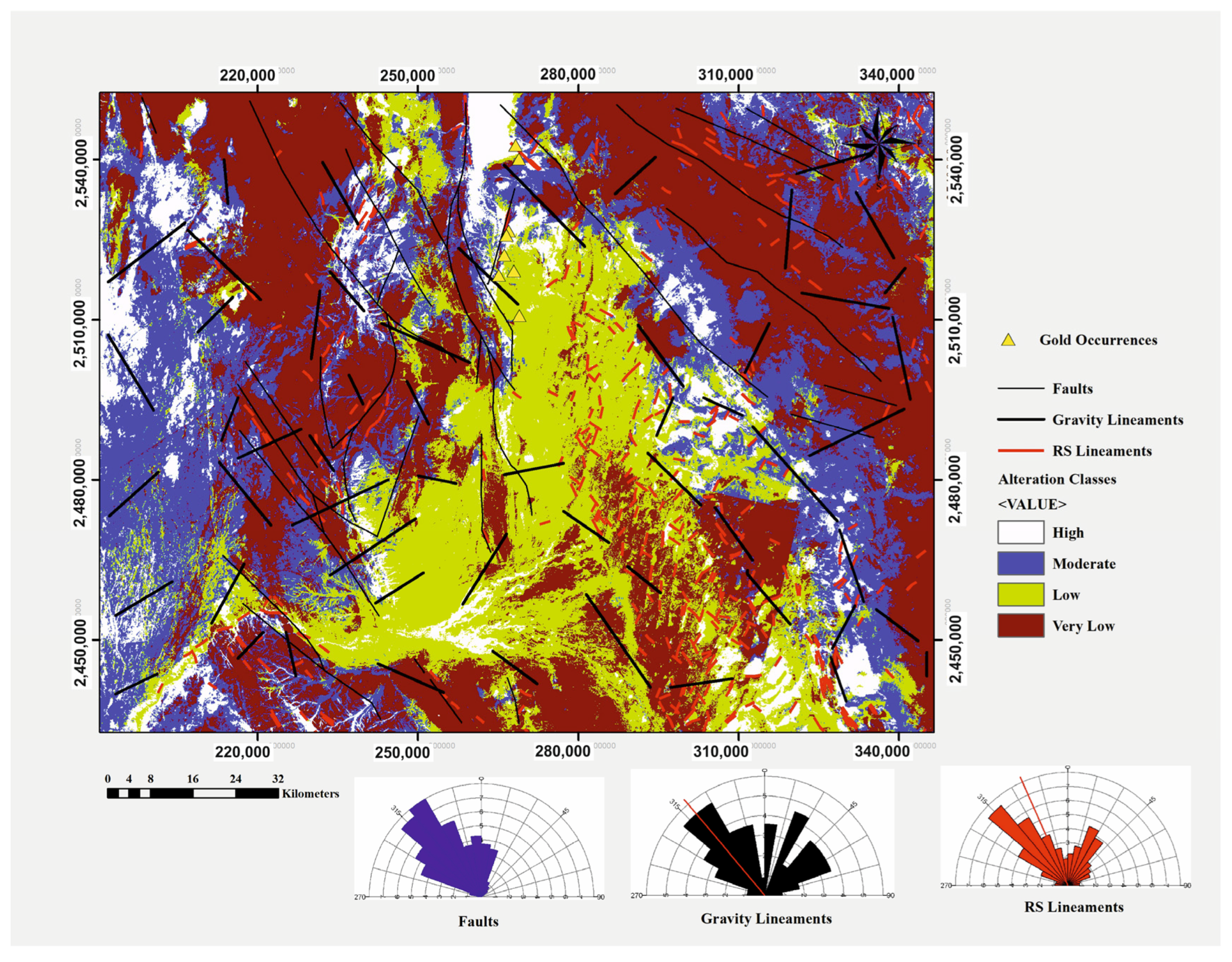
Disclaimer/Publisher’s Note: The statements, opinions and data contained in all publications are solely those of the individual author(s) and contributor(s) and not of MDPI and/or the editor(s). MDPI and/or the editor(s) disclaim responsibility for any injury to people or property resulting from any ideas, methods, instructions or products referred to in the content. |
© 2023 by the authors. Licensee MDPI, Basel, Switzerland. This article is an open access article distributed under the terms and conditions of the Creative Commons Attribution (CC BY) license (https://creativecommons.org/licenses/by/4.0/).
Share and Cite
El-Raouf, A.A.; Doğru, F.; Azab, I.; Jiang, L.; Abdelrahman, K.; Fnais, M.S.; Amer, O. Utilizing Remote Sensing and Satellite-Based Bouguer Gravity data to Predict Potential Sites of Hydrothermal Minerals and Gold Deposits in Central Saudi Arabia. Minerals 2023, 13, 1092. https://doi.org/10.3390/min13081092
El-Raouf AA, Doğru F, Azab I, Jiang L, Abdelrahman K, Fnais MS, Amer O. Utilizing Remote Sensing and Satellite-Based Bouguer Gravity data to Predict Potential Sites of Hydrothermal Minerals and Gold Deposits in Central Saudi Arabia. Minerals. 2023; 13(8):1092. https://doi.org/10.3390/min13081092
Chicago/Turabian StyleEl-Raouf, Amr Abd, Fikret Doğru, Islam Azab, Lincheng Jiang, Kamal Abdelrahman, Mohammed S. Fnais, and Omar Amer. 2023. "Utilizing Remote Sensing and Satellite-Based Bouguer Gravity data to Predict Potential Sites of Hydrothermal Minerals and Gold Deposits in Central Saudi Arabia" Minerals 13, no. 8: 1092. https://doi.org/10.3390/min13081092
APA StyleEl-Raouf, A. A., Doğru, F., Azab, I., Jiang, L., Abdelrahman, K., Fnais, M. S., & Amer, O. (2023). Utilizing Remote Sensing and Satellite-Based Bouguer Gravity data to Predict Potential Sites of Hydrothermal Minerals and Gold Deposits in Central Saudi Arabia. Minerals, 13(8), 1092. https://doi.org/10.3390/min13081092











